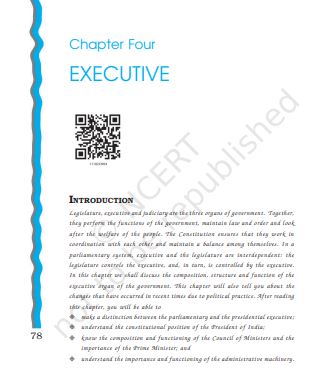‘NCERT Solutions for Class 11 Political Science Chapter 4 Executive‘ PDF Quick download link is given at the bottom of this article. You can see the PDF demo, size of the PDF, page numbers, and direct download Free PDF of ‘Ncert Class 11 Political Science Chapter 4 Exercise Solution’ using the download button.
Executive NCERT Textbook With Solutions Book PDF Free Download

Chapter 4: Executive
Who is in charge of the administration of your school? Who takes important decisions in a school or a university? In any organisation, some office holder has to take decisions and implement those decisions.
We call this activity administration or management. But administration requires a body at the top that will take policy decisions or the big decisions and supervise and coordinate the routine administrative functioning.
You may have heard about the executives of big companies, banks or industrial units. Every formal group has a body of those who function as the chief administrators or the executives of that organization.
Some office holders decide the policies and rules and regulations and then some office holders implement those decisions in the actual day-to-day functioning of the organization.
The word executive means a body of persons that looks after the implementation of rules and regulations in actual practice.
In the case of government also, one body may take policy decisions and decide about rules and regulations, while the other one would be in charge of implementing those rules.
The organ of government that primarily looks after the function of implementation and administration is called the executive.
What are the principal functions of the executive? The executive is the branch of government responsible for the implementation of laws and policies adopted by the legislature.
The executive is often involved in the framing of policy. The official designations of the executive vary from country to country. Some countries have presidents, while others have chancellors.
The executive branch is not just about presidents, prime ministers, and ministers.
It also extends to the administrative machinery (civil servants). While the heads of government and their ministers, saddled with the overall responsibility of government policy, are together known as the political executive, those responsible for day-to-day administration are called the permanent executive.
Every country may not have the same type of executive. You may have heard about the President of the USA and the Queen of England.
But the powers and functions of the President of the USA are very different from the powers of the President of India. Similarly, the powers of the Queen of England are different from the powers of the King of Bhutan.
Both India and France have prime ministers, but their roles are different from each other. Why is this so?
| Author | NCERT |
| Language | English |
| No. of Pages | 22 |
| PDF Size | 2.6 MB |
| Category | Political Science |
| Source/Credits | ncert.nic.in |
NCERT Solutions Class 11 Political Science Chapter 4 Freedom
Question 1.
What is meant by freedom? Is there a relationship between freedom for the individual and freedom for the nation?
Answer:
Freedom refers to doing all those things which do not harm others and, are essential for a person’s own development. There is a close relationship between the freedom of individual and for the nation because:
- If a nation is free, every individual in it will be free to enhance their creativity and capabilities.
- The development of a nation depends on the cooperation, creativity, and capabilities of individuals, which can be exercised in the absence of external constraints.
- A free society enables all its members to develop their potential with the minimum social constraints
- Though, no society can be imagined without the absence of constraints but it is necessary to determine whether it is acceptable or justified.
- Social constraints are necessary to be examined through debates, and discussions between individuals and society.
Question 2.
What is the difference between the negative and positive conception of liberty?
Answer:
Negative conception of liberty:
- It implies the absence of restraints and rights to do whatever one likes.
- This conception may make the powerful person more powerful to keep the weaker ones on their mercy.
- This conception of liberty faces the following drawbacks:
(a) Liberty is concerned with the area control, not with its source, hence, this is not necessary to have democracy to enjoy freedom.
(b) The state should control the liberty of an individual only up to the limit where he interferes in others’ such liberty. The positive conception of liberty:
- It refers to a society in which adequate facilities are available for each and every section of society to enjoy desirable rights.
- This belief is that any individual or section should not hinder the progress of others.
- People can enjoy all freedoms which are permissible by laws.
- It ensures the growth of poor, weak, and downtrodden people also.
- It interprets that liberty lies in the removal of hindrances.
NCERT Class 11 Political Science Textbook Chapter 4 Executive With Answer PDF Free Download
